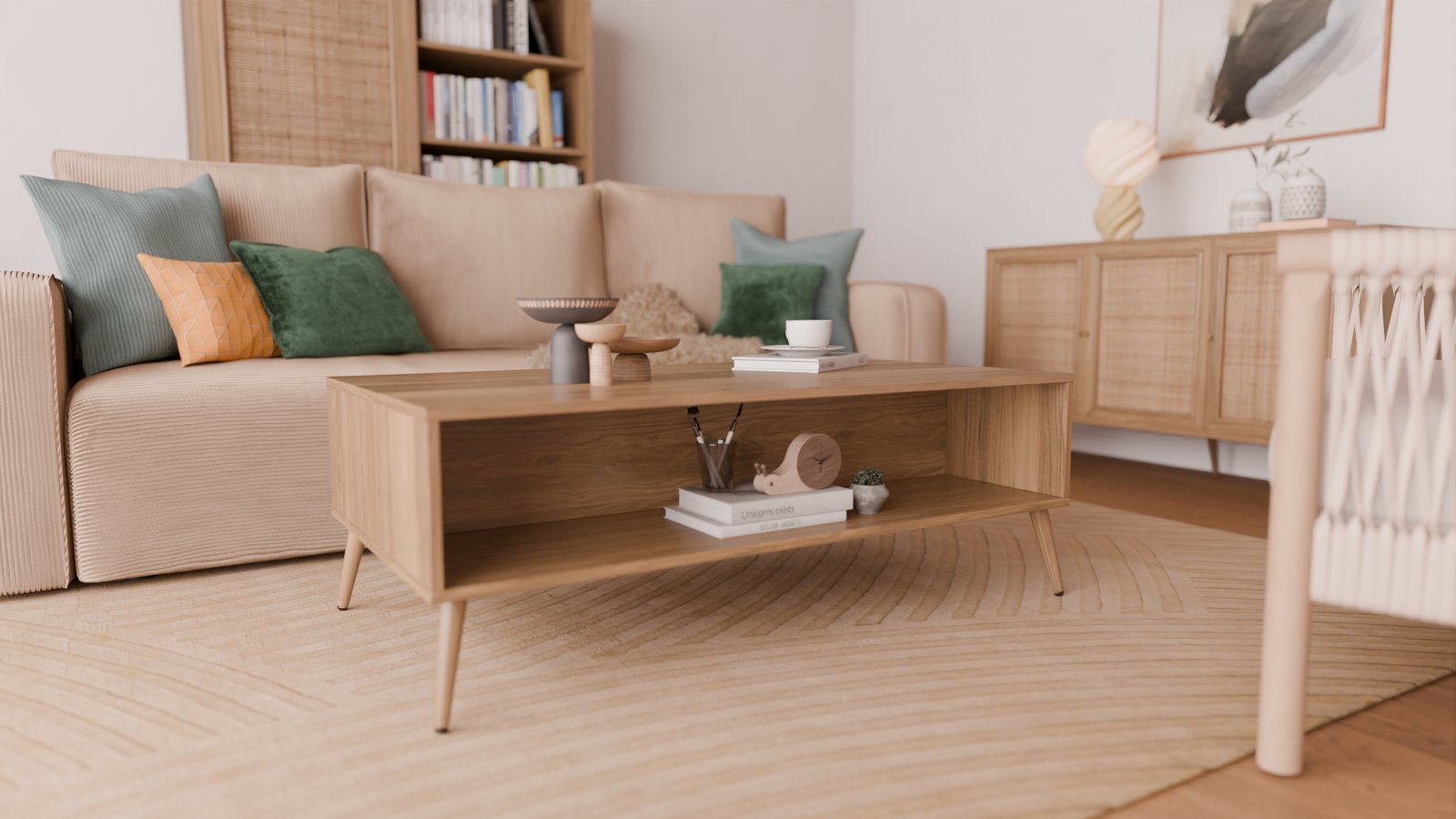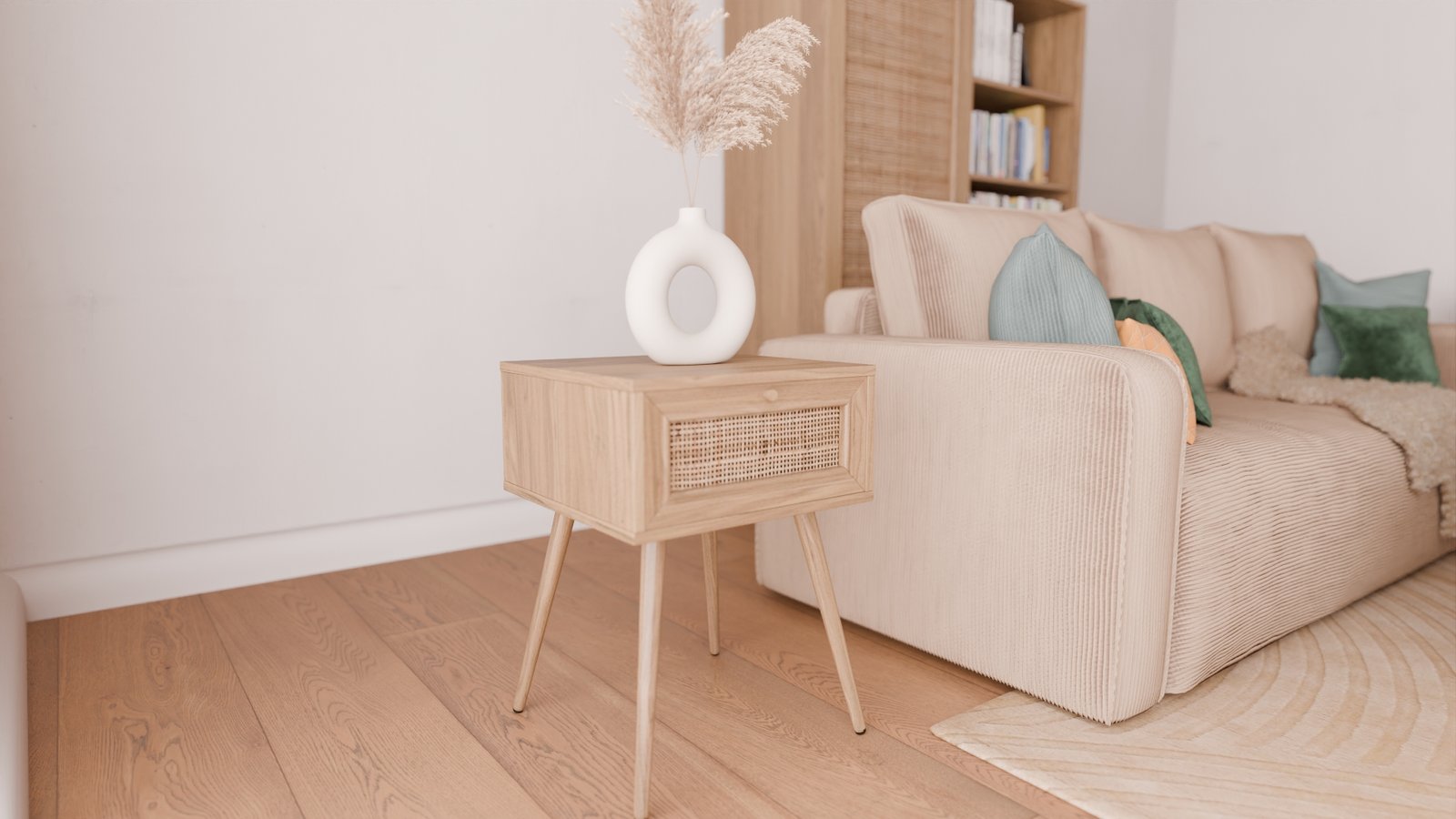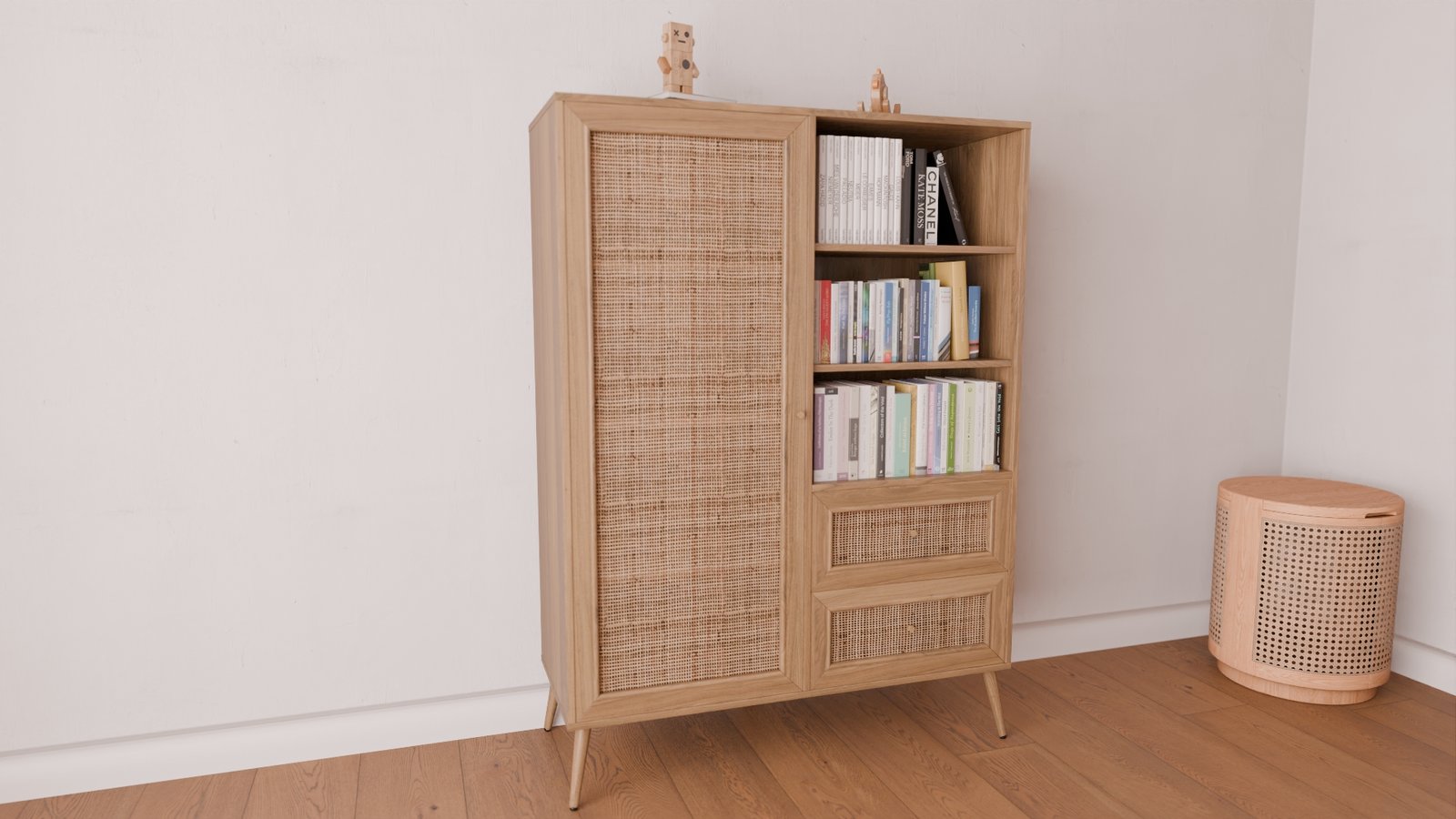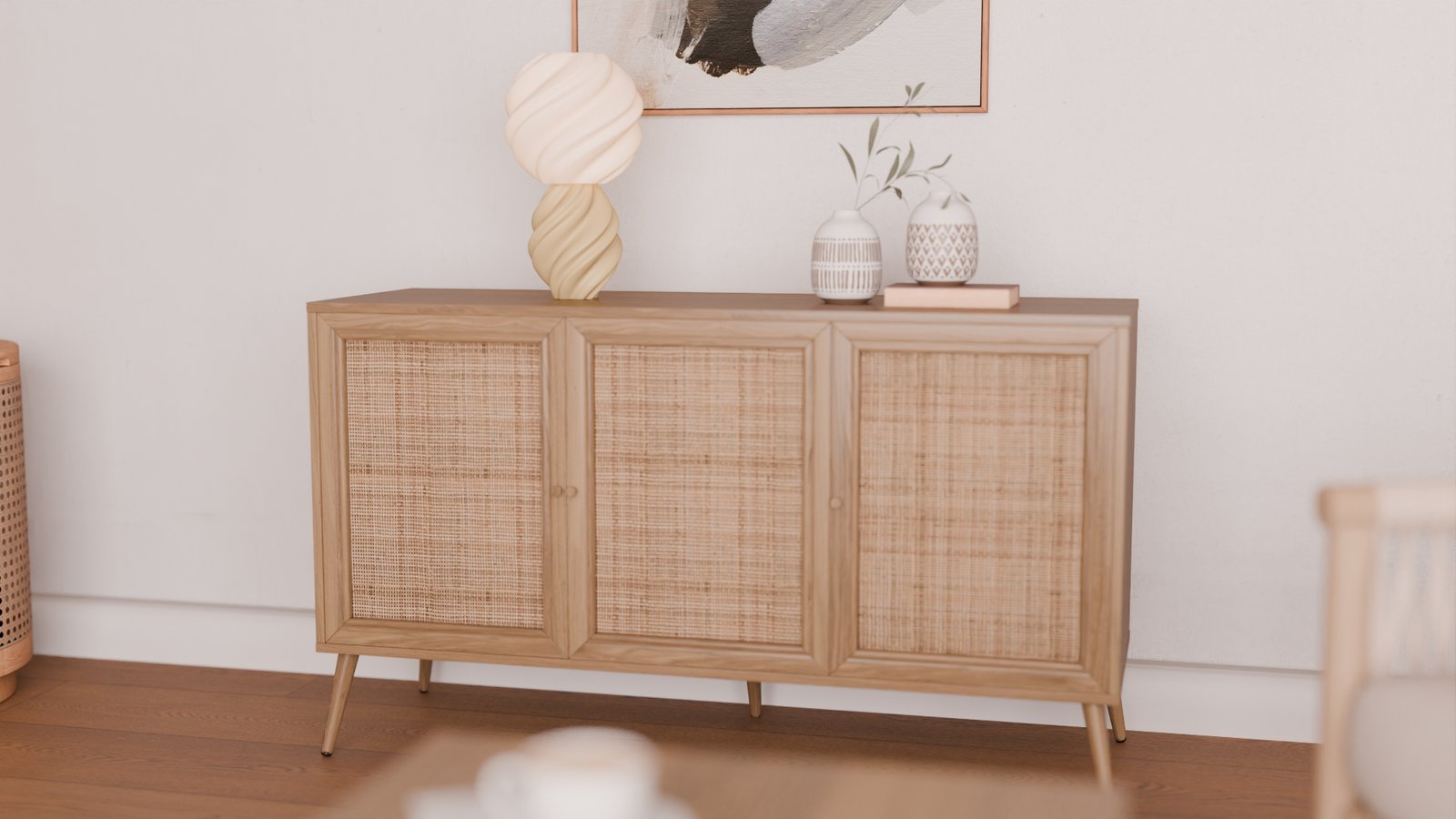Want Japandi Vibes? Here’s How to Get It Right

There’s a calm that shows up when a space finally feels right.
Not just tidy. Not just nice. But right. Like you can breathe easier. Like your thoughts finally have room to stretch out.
That’s Japandi.
And the room we’re working with? It gets it. A beige corduroy sofa. White lounge chairs. Rattan and wood details that keep repeating, softly, like background music. Nothing screams. Everything speaks.
Let’s walk through it, piece by piece—why it works, how it creates Japandi calm, and how you can recreate that same feeling at home.
Table of Contents
The Beige Corduroy Sofa: Warm, Grounded, Understated

Corduroy’s not usually the first thing that comes to mind when you think “minimal.” But here? It works beautifully. The wide beige corduroy catches the light in just the right way. It adds texture without throwing the palette off-balance.
The shape’s simple. Generous without being bulky. And when it sits in the middle of the room, it feels like home without demanding all your attention.
Why this works:
- Texture brings warmth – Corduroy adds dimension while staying soft on the eyes.
- Tonal consistency – Beige works as a neutral anchor that doesn’t flatten the space.
- No unnecessary detail – Clean form, natural comfort. Just how Japandi likes it.
Two Lounge Chairs: Calm Companions, Not Competitors

Set just across from the sofa, fronting the coffee table, these white fabric chairs with warm wood frames are doing subtle work. They open up the space—visually and emotionally. There’s lightness in the way they hold themselves.
No extra cushions. No fuss. Just softness in shape and structure.
Why this works:
- Visual balance – The contrast of light fabric with warm wood keeps things grounded but airy.
- Supports the flow – The chairs don’t block the eye; they invite you in.
- Simplicity that feels complete – Nothing’s missing, but nothing feels overdone.
The Coffee Table: Rattan and Wood at the Center

It’s round. It’s textured. It sits low and wide, with just the right amount of presence.
This rattan-and-wood coffee table doesn’t scream statement piece—but somehow, it becomes one. Especially when paired with the sofa and lounge chairs, it creates a visual pause in the middle of the room.
Why this works:
- Curved edges soften the layout – In Japandi, circles matter. They ease the geometry.
- Natural materials feel lived-in – Rattan and wood echo nature without looking rustic.
- Repeats the language – It speaks the same design vocabulary as the side table, bookshelf, and dresser.
The Rattan Side Table: Quiet, Essential, Never Extra

Tucked beside the lounge chair, the matching rattan side table holds its own.
It’s not big. It’s not bold. But it’s there, doing exactly what it needs to do—providing a spot for your tea, your book, your favorite candle.
Why this works:
- Shape echoes the coffee table – Repetition gives the eye something to trust.
- Color harmony – Matches wood tones across the room without feeling monotonous.
- Function without fanfare – Keeps clutter off the floor, adds purpose without pressure.
The Bookshelf: Open, Airy, and On Theme

Standing tall in one corner, the matching wood-and-rattan bookshelf creates both vertical interest and real storage.
It’s got just enough structure to keep things looking intentional. Line it with neutral ceramics, linen-bound books, or let it breathe with space between.
Why this works:
- Adds height without heaviness – Slim frame, no bulk.
- Continuity in material – Matches the coffee table, side table, and dresser, keeping the story straight.
- Quietly functional – The open design avoids visual clutter.
The Dresser: Grounded and Useful, Without the Bulk

Short, wide, and matching in tone and texture, this dresser offers hidden storage that doesn’t interrupt the atmosphere.
You’d think a dresser in the living room would feel out of place—but here, it doesn’t. It fits, almost like it’s always belonged there.
Why this works:
- Wood and rattan rhythm – Repeats the materials from other pieces for cohesion.
- Horizontal grounding – Balances the taller bookshelf on the other side of the space.
- More function, same softness – Drawers without the drama.
The Storage Side Table: Hidden Helpfulness

Here’s the thing about Japandi: clutter can’t win.
That’s where this little wood storage side table earns its keep. It’s sleek on the outside, smart on the inside. Need a spot for throw blankets, remotes, chargers, or that one notebook you always misplace? Done.
Why this works:
- Clutter stays hidden – The cleaner your surfaces, the calmer your head.
- Matches the palette – Light wood, low profile, total harmony.
- Practical without being bulky – You barely notice it… until you use it.
The Lueur Ondulée Lamp: Soft Light, Sculptural Soul

Now, the piece that changes the whole mood.
The Lueur Ondulée doesn’t just light the room—it shapes it. It sits on the dresser like it belongs there, with that gentle wave in its beige sculptural form. It looks like it was hand-formed by quiet intention.
But turn it on—and something shifts.
Warmth spreads. The rattan glows. The walls feel closer, but in a comforting way.
Why this works:
- Soft curves add movement – No harsh angles, no hard energy.
- Warm light = Japandi soul – Lighting should feel like a hug, not a spotlight.
- Design that doubles as art – Even when it’s off, it’s part of the atmosphere.
This lamp doesn’t try too hard. It doesn’t need to. It’s the kind of piece you can build a mood around.
You can get your own Lueur Ondulée right here and honestly? Once it’s in your room, you’ll wonder how you lived without it.
Final Thoughts: Start Small. Start Soft.
Creating a Japandi living room doesn’t mean replacing everything.
You don’t need a giant haul or a full reno. You need a few pieces that know how to talk to each other. That support your space instead of stealing from it.
Start with one thing that feels right. Maybe it’s a coffee table with honest texture. Maybe it’s a storage side table that keeps life tucked neatly away. Or maybe—if you’re ready to feel that shift the second you flip the switch—it’s the Lueur Ondulée.
Because sometimes the smallest light makes the biggest difference.
